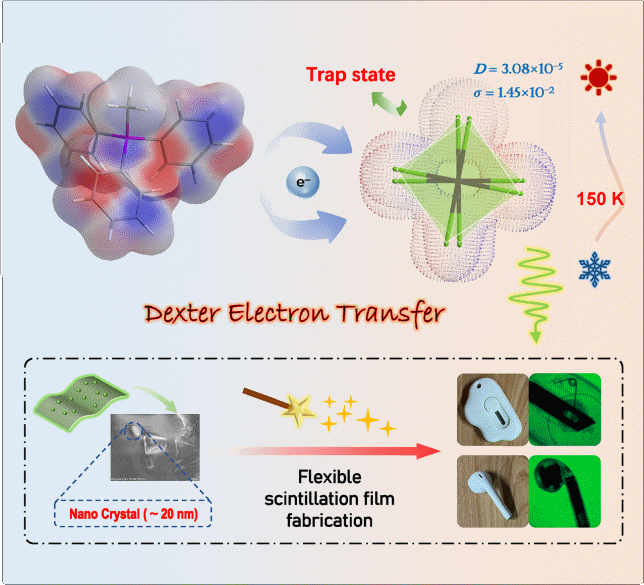X-ray detection technology plays an irreplaceable role in fields such as aerospace, public safety monitoring, disease diagnosis, foreign object detection et al. Scintillators, which serve as the core components in X-ray detection systems, are a class of materials that can convert high-energy radiation (such as X/γ rays, α/β particles, neutrons) into visible or near-visible light. Efficient scintillators require high photoluminescence yield, high energy resolution, swift response time, sensitive ionization detection, and outstanding mechanical and chemical stability.
Manganese (Mn) -based inorganic-organic hybrid metal halide scintillators with superior thermal stability, mechanical strength and processability have prominent applications in nuclear medicine, radiation detection and industrial testing. However, there is a significant lack of research on the effects of temperature on Mn-based scintillators, especially in terms of the mechanisms of luminescence and scintillation. In particular, the mechanism of thermally excited excitons in Mn-based luminescent materials remains unclear.
In a study published in Laser & Photonics Reviews, the research group led by Prof. GUO Guocong from Fujian Institute of Research on the Structure of Matter (FJIRSM) of the Chinese Academy of Sciences carried out a detailed mechanistic study of Mn-based inorganic-organic hybrid metal halide scintillators with rare anomalous thermally excited excitons.
The researchers developed a Mn-based organic-metal halide hybrid nanoscintillator Mn-1 NCs ((mtpp)2MnCl4) with high luminescence efficiency and which can be prepared on a large scale. This scintillating material exhibits a decrease in photoluminescence intensity with increasing temperature within the range of 77 to 150 K. This is due to the fact that the excitation electrons of Mn2+ ions cannot overcome the trap energy level in this temperature interval, which follows the Dexter energy transfer process.
In contrast, within the temperature range of 150 to 350 K, the photoluminescence intensity of Mn-1 NCs increases with rising temperature, even surpassing the intensity observed at 77 K. This increase is due to the increase in temperature assists the trapped charge carriers in escaping the trap layer and returning to the luminescent center of Mn2+ ions through an energy inversion process, partially compensating for the luminescence loss caused by the temperature increase.
Furthermore, the scintillation intensity of Mn-1 NCs surpasses that of the commercial scintillator Bi4Ge3O12, with a detection limit of 1.01 μGyair/s, which is lower than the standard diagnostic dose rate in medical imaging (5.5 μGyair/s). Concurrently, this metal halide scintillating material exhibits superior radiation resistance, solvent stability, and air stability. Flexible scintillating films based on Mn-1 NCs allow for the clear visualization of the internal structures of objects such as utility knives and headphones, achieving an imaging spatial resolution of 11.3 lp/mm.
This study elucidates the luminescence mechanism of organic-inorganic hybrid metal halide scintillating materials, providing new avenues for the design of high-performance scintillators.

Anomalous luminescence behavior of Mn-based organic-metal halide hybrid scintillation nanocrystals in response to temperature and X-ray imaging studies(Image by Prof. GUO’s group)
Contact:
Prof. GUO Guocong
Fujian Institute of Research on the Structure of Matter
Chinese Academy of Sciences
Email: gcguo@fjirsm.ac.cn